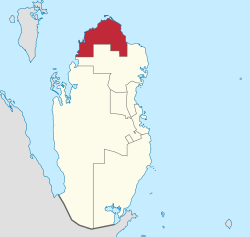Zubarah
الزبارة Al Zubarah Az Zubarah | |
|---|---|
Ruined town | |
 The iconic Al Zubarah Fort. | |
 Geographical location of Zubarah. | |
 Al Shamal in Qatar. | |
| Coordinates: 25°58′43″N 51°01′35″E / 25.97861°N 51.02639°E | |
| Country | Qatar |
| Municipality | Al Shamal |
| Zone no. | 78 |
| Area | |
• Total | 4.6 km2 (1.8 sq mi) |
| • Land | 4 km2 (2 sq mi) |
| Demonym(s) | Zubaran Al Zubaran |
| Official name | Al Zubarah Archaeological Site |
| Type | Cultural |
| Criteria | iii, iv, v |
| Designated | 2013 (37th session) |
| Reference no. | 1402 |
| Region | Western Asia |
Zubarah (Arabic: الزبارة), also referred to as Al Zubarah or Az Zubarah, is a ruined, ancient town located on the northwestern coast of the Qatar peninsula in the Al Shamal municipality, about 65 miles or 105 kilometres from the capital Doha. It was founded by Shaikh Muhammed bin Khalifa, the founder father of Al Khalifa royal family of Bahrain, the principal Utub tribe in the first half of the eighteenth century.[1][2][3][4][5] It was designated a UNESCO World Heritage Site in 2013.[6]
It was once a successful center of global trade and pearl fishing positioned midway between the Strait of Hormuz and the west arm of the Persian Gulf. It is one of the most extensive and best-preserved examples of an 18th–19th century settlement in the region. The layout and urban fabric of the settlement have been preserved in a manner unlike any other settlements in the Persian Gulf, providing insight into the urban life, spatial organization, and the social and economic history of the Persian Gulf before the discovery of oil and gas in the 20th century.[7]
Covering an area of around 400 hectares (60 hectares inside the outer town wall), Zubarah is Qatar's most substantial archaeological site. The site comprises the fortified town with a later inner and an earlier outer wall, a harbour, a sea canal, two screening walls, Qal'at Murair (Murair fort), and the more recent Zubarah Fort.[8]
- ^ تاريخ نجد – خالد الفرج الدوسري – ص 239
- ^ Rihani, Ameen Fares (1930), Around the coasts of Arabia, Houghton Mifflin Company, page 297
- ^ Arabian Frontiers: The Story of Britain’s Boundary Drawing in the Desert, John C Wilkinson, p44
- ^ قلائد النحرين في تاريخ البحرين تأليف ناصر بن جوهر بن مبارك الخيري، تقديم ودراسة عبدالرحمن بن عبدالله الشقير،2003، ص 215.
- ^ المصالح البريطانية في الكويت حتى عام 1939، أحمد حسن جودة، ترجمة حسن النجار، مطبعة الارشاد، بغداد، 1979، ص 35
- ^ Cite error: The named reference
dswas invoked but never defined (see the help page). - ^ Richter, T., Wordsworth, P. D. & Walmsley, A. G. 2011: Pearlfishers, townsfolk, Bedouin and Shaykhs: economic and social relations in Islamic Al-Zubarah. P. 2. In Proceedings of the Seminar for Arabian Studies. 41, p. 1-16
- ^ "Qatar Islamic Archaeology and Heritage Project". University of Copenhagen. 2010-10-11. Retrieved 14 February 2015.
